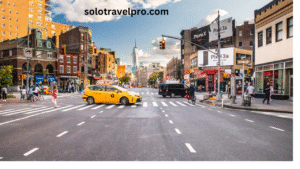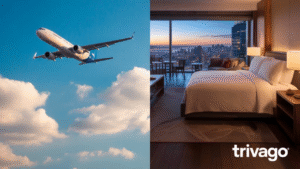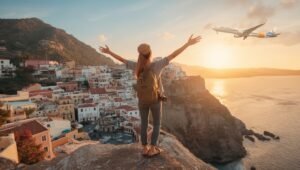The Ultimate Solo Travel Guide Your Complete Adventure Handbook
There’s something magical about stepping off a plane in a foreign country with nothing but your backpack and an open heart. I still remember my first solo trip to Iceland five years ago – I was terrified, excited, and completely unprepared for how much that journey would change my life. Today, after exploring over 30 countries on my own, I want to share everything I’ve learned about the incredible world of solo travel.

Table of Contents
Why Solo Travel is the Ultimate Adventure
Solo travel isn’t just a trend – it’s a transformative experience that millions of Americans are embracing. According to recent travel industry data, solo travel bookings have increased by 42% among US travelers in the past three years. But why are so many people choosing to explore the world alone?
Freedom & Flexibility
When you travel solo, you become the master of your own adventure. Want to spend three hours wandering through a local market in Bangkok? Go for it. Feel like changing your entire itinerary because you heard about an amazing hidden waterfall? No problem.
I learned this lesson during my solo trip to Italy. I had planned to spend just one day in Florence, but I fell so in love with the Renaissance art and charming streets that I extended my stay by four days. If I had been traveling with others, this spontaneous decision would have been impossible. Solo travel gives you the ultimate freedom to follow your instincts and create your own unique journey.
Key Benefits of Solo Travel Freedom:
- Complete control over your schedule and activities
- Ability to make spontaneous decisions without consulting others
- Freedom to travel at your own pace
- Opportunity to pursue your specific interests without compromise
Discovering Your True Self
Solo travel strips away the familiar layers of your daily life and reveals who you really are. Without the influence of friends, family, or colleagues, you’re forced to make decisions based purely on your own desires and instincts. This process of self-discovery can be profound and life-changing.
During my solo journey through Japan, I discovered I was much braver than I had ever imagined. I found myself striking up conversations with locals despite the language barrier, trying foods I never would have considered, and navigating complex train systems with confidence. These experiences taught me that I was capable of far more than I had ever believed.
Many solo travelers report similar revelations. They discover hidden strengths, uncover new passions, and gain a deeper understanding of their values and priorities. This self-awareness often leads to positive changes in their personal and professional lives long after they return home.
Breaking Out of Your Comfort Zone
Comfort zones are cozy, but they’re also limiting. Solo travel naturally pushes you beyond these boundaries in ways that group travel simply cannot. When you’re alone in a foreign country, you must rely on yourself to navigate challenges, solve problems, and make connections.
I remember feeling anxious about dining alone during my first solo trip. The thought of sitting by myself in restaurants felt awkward and uncomfortable. However, I quickly learned that solo dining opened up opportunities for conversations with locals and fellow travelers that I never would have experienced otherwise. Some of my most memorable travel moments happened because I was alone and approachable.
Common Comfort Zone Challenges Solo Travelers Overcome:
- Fear of eating alone in restaurants
- Anxiety about getting lost or confused
- Nervousness about meeting new people
- Worry about language barriers
- Concern about safety in unfamiliar places
Planning Your First Solo Trip – Step-by-Step Guide
Planning your first solo adventure can feel overwhelming, but breaking it down into manageable steps makes the process much more approachable. After years of solo travel and helping friends plan their own adventures, I’ve developed a foolproof system that takes the stress out of trip planning.
Choosing the Right Destination
Your first solo destination should balance adventure with comfort. Look for places that are solo-traveler friendly, relatively safe, and align with your interests and experience level. Consider factors like language barriers, cultural differences, infrastructure quality, and the availability of other solo travelers.
Best First-Time Solo Destinations for Americans:
Destination | Why It’s Perfect | Best For |
Canada | English-speaking, familiar culture | First-timers |
Ireland | Friendly locals, easy transportation | Culture lovers |
Australia | Similar culture, excellent infrastructure | Adventure seekers |
Netherlands | English widely spoken, bike-friendly | Urban explorers |
Costa Rica | Well-developed tourism, natural beauty | Nature enthusiasts |
When I help friends choose their first solo destination, I always ask them to consider what excites them most about travel. Are you drawn to ancient history, natural wonders, vibrant cities, or cultural experiences? Your destination should align with your passions while providing a supportive environment for your first solo adventure.
Setting a Realistic Budget
Solo travel can be more expensive per person since you can’t split accommodation costs, but it can also be incredibly budget-friendly if you plan wisely. The key is understanding all potential costs and planning accordingly.
Essential Budget Categories:
- Transportation: Flights, local transportation, airport transfers
- Accommodation: Hotels, hostels, Airbnb, or alternative lodging
- Food: Restaurant meals, street food, groceries, cooking facilities
- Activities: Tours, entrance fees, experiences, entertainment
- Miscellaneous: Shopping, tips, emergency funds, travel insurance
I recommend allocating 20% more than your initial budget estimate for unexpected expenses and spontaneous experiences. Some of my best travel memories came from unplanned activities that I could afford because I had budgeted wisely.
Money-Saving Strategies for Solo Travelers:
- Choose destinations during shoulder seasons for better prices
- Book accommodations with kitchen facilities to cook some meals
- Use public transportation instead of taxis when possible
- Look for free walking tours and local events
- Consider house-sitting or work-exchange programs
Booking Flights & Accommodation
Timing and flexibility are crucial when booking solo travel arrangements. I’ve learned that being strategic about booking can save hundreds of dollars while ensuring better experiences.
For flights, I typically start monitoring prices 6-8 weeks before my intended departure date. Tuesday and Wednesday flights are often cheaper than weekend departures, and I’m always willing to adjust my travel dates by a few days to secure better deals.
Accommodation choices significantly impact your solo travel experience. While luxury hotels offer comfort and security, they can be isolating for solo travelers. I’ve had much better experiences staying in places where I could meet other travelers, like boutique hostels, guesthouses, or centrally located Airbnb properties.
Solo Accommodation Options Ranked:
- Boutique Hostels – Social atmosphere, safety, budget-friendly
- Guesthouses/B&Bs – Personal service, local insights, moderate cost
- Central Airbnb – Privacy with flexibility, kitchen access
- Mid-range Hotels – Comfort and services, moderate social opportunities
- Luxury Hotels – Maximum comfort but potentially isolating
Creating a Travel Itinerary Without Stress
The best solo travel itineraries balance structure with flexibility. I recommend planning your must-see attractions and booking essential reservations while leaving plenty of room for spontaneous discoveries.
My approach involves identifying 2-3 “anchor” activities per day – things I definitely want to do – while keeping the rest of my time flexible. This strategy ensures I experience the highlights while remaining open to unexpected opportunities.
Effective Itinerary Planning Steps:
- Research your destination’s top attractions and experiences
- Group activities by location to minimize travel time
- Book time-sensitive or limited-capacity activities in advance
- Leave at least 30% of your time unplanned
- Research backup indoor activities for bad weather
- Identify safe, well-reviewed restaurants near your accommodation

Safety Tips Every Solo Traveler Should Know
Safety is the number one concern for most potential solo travelers, and rightfully so. However, with proper preparation and awareness, solo travel can be just as safe as any other form of travel. I’ve never had a serious safety issue during my solo adventures, and that’s largely due to the precautions I take before and during my trips.
Research Your Destination Before You Go
Knowledge is your best defense against potential problems. I spend considerable time researching each destination before I travel, and this preparation has saved me from uncomfortable or dangerous situations countless times.
Essential Pre-Trip Research:
- Current political and social climate
- Common scams targeting tourists
- Safe neighborhoods vs. areas to avoid
- Local customs and cultural norms
- Emergency contact information
- Transportation options and safety records
- Weather patterns and appropriate clothing
I use multiple sources for my research, including official government travel advisories, recent travel blogs, local tourism websites, and online forums where travelers share current experiences. The U.S. State Department’s travel advisories are particularly valuable for understanding current security situations.
Stay Connected With Friends & Family
Maintaining regular communication with people back home isn’t just reassuring for your loved ones – it’s a crucial safety practice. I’ve developed a system that keeps my family informed without being burdensome.
Before each trip, I share my complete itinerary, including flight details, accommodation information, and planned activities. I also establish a regular check-in schedule that works for both my travel plans and my family’s expectations.
Smart Communication Strategies:
- Share your itinerary with trusted contacts before departure
- Establish regular check-in times via messaging apps
- Use location-sharing features on your phone when appropriate
- Keep emergency contacts easily accessible in your phone
- Consider purchasing an international phone plan or local SIM card
Avoid Risky Areas and Scams
Every destination has areas that are best avoided, especially by solo travelers. Learning to identify and avoid these situations is essential for safe solo travel. I’ve developed a good instinct for recognizing potentially risky situations, but this skill came from experience and education.
Common red flags I watch for include overly friendly strangers offering unsolicited help, deals that seem too good to be true, requests to go to secondary locations, and situations where I feel pressured to make quick decisions.
Common Solo Travel Scams to Watch For:
- Fake police or authority figures demanding documents or money
- “Helpful” locals leading you to overpriced shops or restaurants
- Distraction techniques while accomplices steal your belongings
- Romance scams targeting lonely travelers
- Overcharging for services or transportation
Travel Insurance: Why It’s a Must
Travel insurance isn’t just a good idea for solo travelers – it’s absolutely essential. When you’re traveling alone, you don’t have companions to help if something goes wrong. Quality travel insurance provides both financial protection and practical assistance when you need it most.
I learned this lesson the hard way during a solo trip to Peru when I developed severe altitude sickness and required emergency medical attention. My travel insurance not only covered the medical costs but also provided 24/7 assistance in Spanish, helping me navigate a scary situation in a foreign language.
Essential Travel Insurance Coverage:
- Medical emergencies and evacuation
- Trip cancellation and interruption
- Lost or stolen luggage and personal items
- 24/7 emergency assistance hotline
- Coverage for adventure activities if relevant
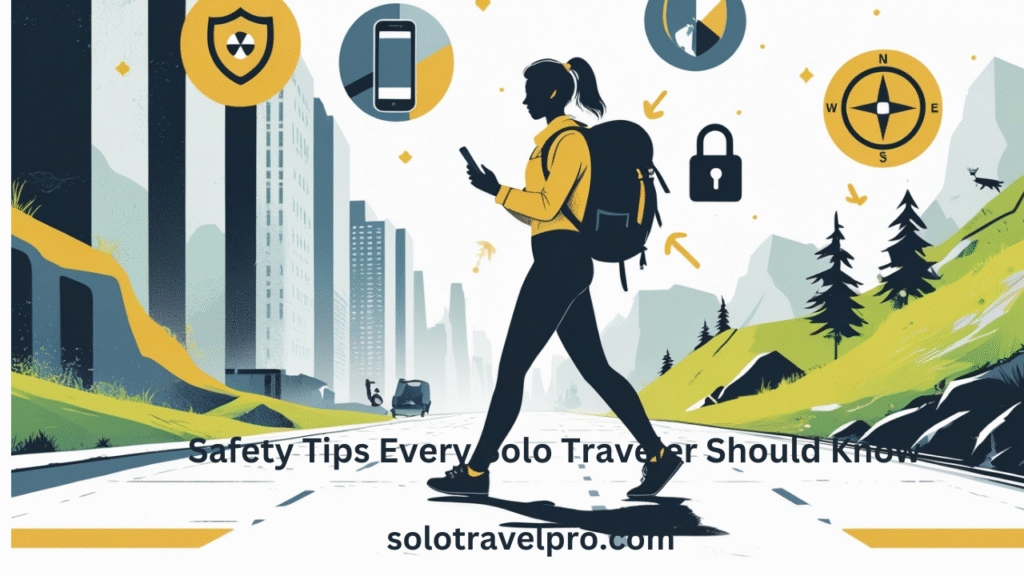
Essential Packing List for Solo Travelers
Packing for solo travel requires a different approach than packing for group trips. You need to be more self-sufficient while still traveling light enough to manage your luggage alone. After years of trial and error, I’ve perfected my solo travel packing strategy.
Travel Light but Smart
The golden rule of solo travel is that you should be able to carry all your luggage comfortably by yourself. This means choosing versatile items that serve multiple purposes and being ruthless about what you actually need versus what you think you might want.
I follow the “one week rule” – I pack for one week regardless of trip length and do laundry as needed. This approach keeps my luggage manageable while ensuring I have everything I need.
Smart Packing Strategies:
- Choose a versatile color palette (2-3 colors maximum)
- Pack items that can be mixed, matched, and layered
- Prioritize quick-dry, wrinkle-resistant fabrics
- Bring only the electronics you’ll actually use
- Pack one “nice” outfit for special occasions
Must-Have Travel Gadgets
Technology can be a solo traveler’s best friend, providing navigation, translation, communication, and entertainment capabilities. However, it’s important to balance usefulness with weight and complexity.
Essential Tech for Solo Travelers:
- Smartphone with offline maps: Your lifeline for navigation and communication
- Portable charger/power bank: Keep devices charged when outlets aren’t available
- Universal adapter: Stay connected regardless of plug types
- Noise-canceling headphones: Block out distractions and enjoy entertainment
- Lightweight laptop/tablet: For planning, booking, and staying connected
I always carry backup charging cables and keep important documents stored both physically and digitally in secure cloud storage. Technology failures happen, so having redundancies is crucial when you’re traveling alone.
Clothing & Footwear Essentials
Your clothing choices can significantly impact your solo travel experience. Comfortable, appropriate clothing helps you blend in with locals, stay comfortable during long days of exploration, and be prepared for various activities and weather conditions.
Solo Traveler’s Wardrobe Essentials:
Item | Quantity | Purpose |
Comfortable walking shoes | 1 pair | Daily exploration |
Dressier shoes | 1 pair | Nice dinners, cultural sites |
Versatile pants/jeans | 2-3 pairs | Everyday wear |
Comfortable shorts | 2 pairs | Warm weather/casual |
Basic t-shirts | 4-5 | Layering and comfort |
Long-sleeve shirts | 2 | Sun protection, modesty |
Light jacket/cardigan | 1 | Weather changes |
Underwear/socks | 7-10 days worth | Comfort essentials |
First Aid & Emergency Kit
When you’re traveling alone, you become your own first responder. A well-stocked first aid kit can handle minor injuries and illnesses that might otherwise ruin your trip or require expensive medical visits.
Solo Traveler’s First Aid Essentials:
- Basic medications (pain relievers, anti-diarrheal, allergy medicine)
- Bandages and antiseptic wipes
- Thermometer
- Any prescription medications with extra supplies
- Emergency contact information
- Copy of travel insurance policy
- Basic sewing kit for clothing repairs
Best Solo Travel Destinations in the USA
America offers incredible opportunities for solo travelers, from vibrant cities to stunning national parks. I’ve explored dozens of US destinations solo and have identified several that are particularly well-suited for independent travelers.
New York City – For the Urban Explorer
New York City is the ultimate solo travel destination for urban adventurers. The city never sleeps, which means there’s always something happening regardless of your schedule. The extensive public transportation system makes it easy to navigate without a car, and the sheer number of attractions means you’ll never run out of things to do.
What makes NYC perfect for solo travelers is its anonymous nature – nobody cares if you’re dining alone, exploring museums solo, or wandering through neighborhoods by yourself. In fact, many of the city’s best experiences are enhanced when you’re alone and can move at your own pace.
Must-Do Solo Experiences in NYC:
- Take a solo food tour through different neighborhoods
- Spend a morning people-watching in Central Park
- Explore world-class museums at your own pace
- Catch a Broadway show (single tickets are often easier to get)
- Walk across the Brooklyn Bridge at sunset
The city’s incredible diversity also means you can find communities and experiences that align with any interest. Whether you’re into art, food, music, fashion, or history, NYC has neighborhoods and venues dedicated to your passions.
San Francisco – For Cultural Vibes
San Francisco combines urban sophistication with natural beauty, creating an ideal environment for solo exploration. The city’s compact size makes it walkable, while its diverse neighborhoods offer distinct experiences and cultures to discover.
I love San Francisco for solo travel because it strikes the perfect balance between big city energy and small town friendliness. Locals are generally helpful and welcoming to visitors, and the city’s progressive culture makes it particularly comfortable for all types of solo travelers.
San Francisco Solo Travel Highlights:
- Ride the iconic cable cars for scenic city views
- Explore diverse neighborhoods like Chinatown, Mission, and Castro
- Visit Alcatraz Island for fascinating history
- Walk or bike across the Golden Gate Bridge
- Experience the eclectic food scene in Ferry Building Marketplace
Austin, Texas – For Music & Food Lovers
Austin’s slogan “Keep Austin Weird” perfectly captures the city’s welcoming attitude toward individuals who march to their own beat. This makes it an outstanding destination for solo travelers who want to experience authentic American culture with a unique twist.
The city’s incredible live music scene means there’s always entertainment available, and the friendly local culture makes it easy to strike up conversations with fellow music lovers. Austin’s food scene is equally impressive, with everything from food trucks to fine dining representing the city’s creative spirit.
Austin Solo Adventure Essentials:
- Catch live music on legendary 6th Street
- Explore the South by Southwest (SXSW) festival atmosphere year-round
- Sample BBQ and food trucks throughout the city
- Kayak or paddleboard on Lady Bird Lake
- Visit the quirky shops and galleries on South Lamar
Seattle, Washington – For Nature & Coffee Fans
Seattle offers the perfect combination of urban amenities and natural beauty, making it ideal for solo travelers who want both city experiences and outdoor adventures. The city’s coffee culture provides perfect spots for solo travelers to relax, plan, and observe local life.
What I particularly appreciate about Seattle is how easy it is to transition from urban exploration to natural environments. You can spend the morning exploring Pike Place Market and the afternoon hiking in the nearby mountains or walking along Puget Sound.
Seattle Solo Travel Must-Dos:
- Explore Pike Place Market and watch the famous fish throwing
- Take a ferry to Bainbridge Island for stunning city views
- Hike in nearby Mount Rainier or Olympic National Parks
- Visit the original Starbucks and explore local coffee culture
- Discover the vibrant arts scene in neighborhoods like Capitol Hill
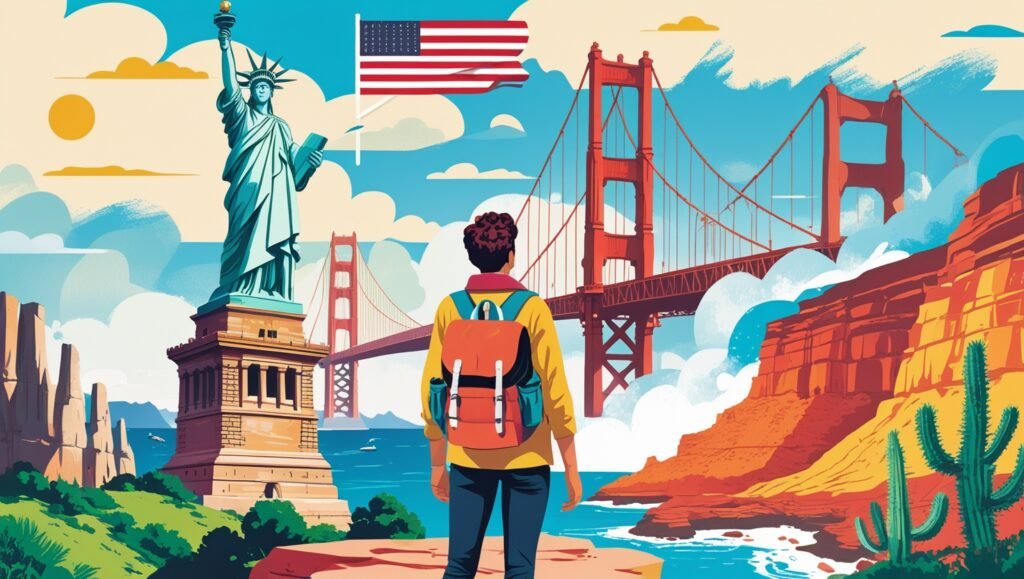
Top International Destinations for US Solo Travelers
International solo travel opens up a world of possibilities for American adventurers. I’ve carefully selected destinations that offer incredible experiences while being accessible and safe for solo US travelers.
Japan – For Tradition Meets Modernity
Japan consistently ranks as one of the safest and most solo-traveler-friendly destinations in the world. The country’s unique blend of ancient traditions and cutting-edge technology creates endless fascinating experiences for independent explorers.
What makes Japan exceptional for solo travel is the culture of respect and helpfulness. Even with language barriers, locals often go out of their way to assist lost-looking travelers. The country’s efficient transportation system and clear signage (often in English) make navigation straightforward.
Japan Solo Travel Experiences:
- Stay in a traditional ryokan (inn) for authentic cultural immersion
- Explore Tokyo’s diverse neighborhoods, each with distinct personalities
- Visit ancient temples and participate in meditation sessions
- Experience the precision and beauty of Japanese gardens
- Enjoy the safety and efficiency of traveling alone on the bullet train system
The food culture in Japan is particularly welcoming to solo travelers. Many restaurants have counter seating specifically designed for individual diners, and eating alone is completely normal and accepted.
Italy – For Romance & History
Italy might be famous as a romantic destination, but it’s equally magical for solo travelers. The country’s rich history, incredible art, delicious food, and warm people create unforgettable experiences for independent adventurers.
I’ve found that traveling solo in Italy actually enhances the experience. You can spend as much time as you want admiring Renaissance art in Florence, linger over perfect pasta in small Roman trattorias, or explore Venice’s winding canals at your own pace without worrying about others’ interests or schedules.
Italian Solo Adventure Highlights:
- Take cooking classes to learn authentic regional recipes
- Explore world-renowned art museums without time constraints
- Wander through ancient Roman ruins and imagine life centuries ago
- Enjoy long, leisurely meals while people-watching in piazzas
- Take scenic train rides through the Tuscan countryside
Thailand – For Budget Adventures
Thailand has earned its reputation as a backpacker paradise, but it’s equally fantastic for solo travelers of all ages and budgets. The country offers incredible value for money, friendly locals, delicious food, and diverse experiences from bustling cities to pristine beaches.
The well-developed tourism infrastructure in Thailand makes it easy for solo travelers to get around safely and comfortably. You’ll find other solo travelers everywhere, creating natural opportunities for socializing while still maintaining your independence.
Thailand Solo Travel Must-Experiences:
- Learn to cook authentic Thai cuisine in hands-on cooking classes
- Explore ancient temples and learn about Buddhist philosophy
- Island-hop in the south to find your perfect beach paradise
- Navigate floating markets and experience local commerce
- Get traditional Thai massages for ultimate relaxation
Iceland – For Scenic Landscapes
Iceland offers some of the most dramatic and beautiful landscapes on Earth, making it a bucket-list destination for solo travelers who love natural wonders. The country’s small size and excellent infrastructure make it perfect for independent exploration.
What makes Iceland special for solo travel is the sense of adventure and discovery. You can witness geysers erupting, walk behind waterfalls, soak in natural hot springs, and potentially see the Northern Lights – all at your own pace and on your own schedule.
Iceland Solo Adventure Essentials:
- Drive the famous Ring Road for diverse landscape experiences
- Soak in the Blue Lagoon and other natural geothermal pools
- Chase the Northern Lights during winter months
- Explore ice caves and glacier formations
- Witness the raw power of geysers and waterfalls
How to Meet People While Traveling Alone
One of the most common concerns about solo travel is loneliness, but I’ve found that traveling alone often leads to more meaningful connections than group travel. When you’re alone, you’re more approachable and more likely to engage with others.
Join Group Tours or Day Trips
Group tours and day trips provide structured opportunities to meet fellow travelers while exploring new destinations. I’ve made some of my closest travel friendships on walking tours, food tours, and adventure excursions.
The key is choosing tours that align with your interests and travel style. Small group tours (8-15 people) tend to be more social and allow for better connections than large bus tours.
Best Types of Tours for Meeting People:
- Walking tours of historic city centers
- Food and wine tasting experiences
- Adventure activities like hiking or kayaking
- Cultural workshops and classes
- Photography tours
Stay in Social Accommodations (Hostels, BnBs)
Your accommodation choice significantly impacts your social opportunities while traveling solo. While luxury hotels offer comfort and privacy, they can be isolating for solo travelers looking to connect with others.
Hostels aren’t just for young backpackers anymore – many cities have upscale hostels that cater to travelers of all ages. These accommodations often have common areas, organized activities, and a natural social atmosphere that makes meeting people easy and natural.
Social Accommodation Options:
- Modern hostels with private rooms and social spaces
- Boutique guesthouses with communal breakfast areas
- Homestays and B&Bs with interactive hosts
- Co-living spaces designed for travelers
- Airbnb properties in social neighborhoods
Use Travel Meetup Apps
Technology has revolutionized how solo travelers connect with each other. Several apps and platforms are specifically designed to help travelers meet like-minded individuals for activities, meals, or exploration.
Popular Solo Travel Social Apps:
- Meetup: Find local groups and activities in your destination
- Backpackr: Connect with other travelers in real-time
- Tourlina: Female-focused travel companion finding
- Travello: Social network for travelers and locals
- Showaround: Meet local guides for authentic experiences
Learn a Few Phrases in the Local Language
Making an effort to communicate in the local language, even at a basic level, shows respect for local culture and often leads to warmer interactions. You don’t need to be fluent – even simple phrases like greetings, “please,” “thank you,” and “excuse me” can open doors to connections.
I’ve found that locals really appreciate when travelers make an effort to speak their language, even if it’s broken or heavily accented. These attempts often lead to patient locals helping you practice, sharing recommendations, or even inviting you to local experiences.
Essential Phrases for Any Destination:
- Hello/Good morning/Good evening
- Please/Thank you/You’re welcome
- Excuse me/I’m sorry
- Do you speak English?
- Where is…?
- How much does this cost?
- The food is delicious
- Can you help me?
Overcoming Challenges in Solo Travel
Solo travel isn’t always easy, and being honest about potential challenges helps you prepare mentally and practically for your adventures. I’ve faced all of these challenges during my solo travels, and overcoming them has made me a more confident and resilient person.
Dealing With Loneliness
Loneliness is probably the most common concern people express about solo travel, and it’s a valid worry. There will be moments during solo trips when you wish you had someone to share an amazing sunset with or to laugh with about a funny cultural misunderstanding.
However, I’ve learned that loneliness and being alone are two different things. You can feel lonely in a crowded room with friends, and you can feel completely content and fulfilled while sitting alone in a café in Paris watching the world go by.
Strategies for Managing Solo Travel Loneliness:
- Embrace solitude as an opportunity for self-reflection and growth
- Stay connected with friends and family through messaging and video calls
- Engage with locals and fellow travelers through activities and shared experiences
- Document your journey through journaling or photography
- Plan activities that naturally involve interaction with others
When Loneliness Becomes a Problem: If feelings of loneliness become overwhelming or persistent, it’s important to address them proactively. Consider joining group tours, staying in more social accommodations, or even adjusting your itinerary to include more interactive experiences.
Managing Language Barriers
Language barriers can be frustrating and sometimes overwhelming, especially when you need help with important things like transportation, accommodation, or medical issues. However, I’ve traveled successfully in countries where I spoke virtually none of the local language.
The key is preparation and maintaining a sense of humor about miscommunications. Most people are patient and helpful when they see you’re making an effort to communicate respectfully.
Practical Language Barrier Solutions:
- Download offline translation apps before your trip
- Learn basic numbers, directions, and courtesy phrases
- Carry a small phrase book or language card
- Use visual aids like maps, pictures, or pointing
- Write down important addresses and destinations in local script
- Stay at accommodations where staff speak some English
Technology Tools for Language Barriers:
- Google Translate: Offline translation and camera features
- iTranslate: Voice translation capabilities
- Duolingo: Learn basic phrases before traveling
- Point It Book: Visual dictionary for pointing at items
Handling Unexpected Changes
Solo travel often involves more uncertainty than group travel, and unexpected changes to plans are common. Flight delays, weather issues, closed attractions, or accommodation problems can be more stressful when you’re handling them alone.
The key to managing unexpected changes is maintaining flexibility and viewing them as part of the adventure rather than problems to be stressed about. Some of my best travel memories have come from unplanned detours and spontaneous changes to my itinerary.
Building Resilience for Travel Changes:
- Build buffer time into your itinerary for unexpected delays
- Research backup options for key activities and accommodations
- Keep important contact information easily accessible
- Maintain emergency funds for unexpected expenses
- Develop a “roll with it” mindset that embraces spontaneity
When Changes Become Serious Problems: For major issues like medical emergencies, natural disasters, or political unrest, having comprehensive travel insurance and emergency contacts becomes crucial. Know how to reach your country’s embassy or consulate, and keep emergency numbers programmed in your phone.
Solo Travel Photography Tips
Capturing your solo travel experiences through photography creates lasting memories and allows you to share your adventures with others. However, photographing yourself and your experiences while traveling alone requires different techniques than group travel photography.
How to Take Great Self-Portraits
Self-portraits are an essential skill for solo travelers who want to document their presence in beautiful locations. The key is planning, patience, and creativity in finding ways to capture both yourself and the amazing places you’re visiting.
Self-Portrait Techniques That Actually Work:
- Use natural frames like doorways, arches, or windows to add depth
- Find interesting textures and backgrounds that complement your outfit
- Experiment with different angles – not everything needs to be face-forward
- Include local elements that tell the story of where you are
- Practice your poses and expressions before setting up the shot
- Use burst mode to capture multiple options quickly
Creative Self-Portrait Ideas:
- Silhouettes against dramatic skies or landscapes
- Reflections in windows, puddles, or mirrors
- Shadows cast on interesting surfaces
- Environmental portraits showing you engaged in local activities
- Detail shots of your hands holding local items or food
Using a Tripod & Remote Shutter
A lightweight tripod and remote shutter are game-changers for solo travel photography. These tools give you the flexibility to create professional-looking photos without relying on strangers or settling for awkward arm’s-length selfies.
Tripod Selection for Solo Travelers:
- Weight: Choose the lightest option that still provides stability
- Size: Look for compact models that fit in your luggage
- Versatility: Consider tripods that work for both phones and cameras
- Durability: Invest in quality that will withstand travel conditions
Remote Shutter Options:
- Bluetooth smartphone remote controls
- Camera manufacturer’s wireless remotes
- Intervalometer for timed shots
- Smartphone apps that control your camera remotely
Capturing Natural Moments
The best travel photos often capture authentic, unposed moments that tell the story of your experience. Solo travel actually provides advantages for capturing these natural moments because you’re more likely to blend into your environment and notice small details.
Strategies for Natural Travel Photography:
- Document the journey, not just the destinations
- Capture local daily life and cultural details
- Focus on emotions and experiences rather than just landmarks
- Include food, transportation, and accommodation in your photo story
- Take photos of interactions with locals (with permission)
- Document weather, lighting, and atmospheric conditions
Building a Complete Photo Story:
- Wide shots showing the full scene or landscape
- Medium shots showing you interacting with the environment
- Close-up details that capture textures, colors, and cultural elements
- Behind-the-scenes shots showing the reality of travel
- Photos that capture the mood and atmosphere of each location
Cost of Solo Travel – How to Save Money
Solo travel can be more expensive per person than group travel since you can’t split accommodation and transportation costs. However, with smart planning and strategic choices, you can minimize expenses while maximizing experiences.
Finding Affordable Accommodation
Accommodation often represents the largest expense for solo travelers, but there are numerous strategies for reducing these costs without sacrificing safety or comfort.
Budget Accommodation Strategies:
- Hostels: Modern hostels offer private rooms with shared common areas
- House-sitting: Free accommodation in exchange for pet or home care
- Work exchanges: Programs like Workaway or WWOOF provide lodging for work
- Off-season travel: Visit destinations during less popular times for lower rates
- Alternative neighborhoods: Stay in local areas rather than tourist districts
Accommodation Cost Comparison:
Option | Average Cost/Night | Pros | Cons |
Budget Hostel | $25-45 | Social, central location | Limited privacy |
Guesthouse | $40-80 | Local experience, breakfast | Variable quality |
Airbnb | $50-120 | Kitchen access, local feel | Less service |
Mid-range Hotel | $80-150 | Consistent quality, services | Less character |
House-sitting | Free | Free accommodation, local experience | Limited availability |
Eating on a Budget Without Missing Out
Food is one of the great joys of travel, and you shouldn’t have to sacrifice culinary experiences to stay within budget. The key is balancing splurge meals with budget-friendly options and taking advantage of local food culture.
Budget-Friendly Food Strategies:
- Shop at local markets for fresh, affordable ingredients
- Choose accommodations with kitchen facilities for some self-catering
- Eat your main meal at lunch when prices are often lower
- Explore street food and local fast-casual options
- Ask locals for their favorite affordable restaurants
- Take advantage of happy hours and daily specials
When to Splurge vs. Save:
- Splurge on: Unique local specialties, highly recommended restaurants, cooking classes
- Save on: Breakfast, snacks, familiar international chains, tourist area restaurants
Cultural Food Experiences That Don’t Break the Budget:
- Local cooking classes that include market tours
- Food tours that provide samples from multiple vendors
- Community meals or potluck dinners at hostels
- Religious or cultural festivals with free food offerings
- Farmers markets and food festivals
Transportation Hacks for Solo Travelers
Transportation costs can add up quickly for solo travelers, especially if you’re covering long distances or using expensive options like taxis and ride-shares. However, there are numerous ways to reduce transportation expenses while often improving your travel experience.
Public Transportation Mastery:
- Research day passes and multi-day transportation cards
- Download offline maps and transportation apps before arriving
- Learn the local transportation etiquette and payment methods
- Use public transport during off-peak hours when possible
- Consider walking for short distances to save money and explore
Alternative Transportation Options:
- Bike rentals: Often cheaper than public transport for short trips
- Rideshare with locals: Apps like BlaBlaCar for intercity travel
- Overnight transportation: Save on accommodation while traveling
- Walking tours: Free or tip-based tours that include transportation
- Group transport: Join other travelers for shared taxi costs
When Transportation Splurges Are Worth It:
- Scenic routes that are experiences themselves
- Time-critical connections for flights or important reservations
- Safety concerns in certain areas or times of day
- Comfort during very long travel days
- Special transportation experiences unique to the destination
Solo Travel Myths – Busted
There are numerous myths and misconceptions about solo travel that prevent many people from embarking on incredible adventures. Having traveled extensively on my own and spoken with hundreds of other solo travelers, I can confidently address these common concerns.
It’s Lonely
This is probably the most persistent myth about solo travel, and it’s simply not true for most solo travelers. While there are moments of solitude (which many people actually enjoy), solo travel often leads to more social connections than group travel.
When you travel with others, you tend to stay within your group and are less likely
Conclusion
Solo travel isn’t just about visiting new places – it’s about discovering who you are when stripped of familiar surroundings and support systems. After five years of exploring the world alone and helping countless others plan their first solo adventures, I can confidently say that solo travel has the power to transform your life in ways you never imagined.
Every challenge you’ll face while traveling alone – from navigating foreign transportation systems to overcoming language barriers – builds confidence that extends far beyond your trip. The self-reliance you develop, the cultural awareness you gain, and the connections you make with people from different backgrounds become part of who you are long after you return home.
Yes, solo travel can be intimidating at first. The thought of dining alone, navigating unfamiliar cities, or handling emergencies without companions can trigger anxiety. But remember that millions of people successfully travel solo every year, and the infrastructure exists to support independent travelers virtually everywhere in the world.
Start small if you need to. Plan a weekend solo trip to a nearby city, or extend a business trip by a few days to explore on your own. Each solo experience builds your confidence for bigger adventures. Before you know it, you’ll be planning multi-week international journeys with the same ease you once reserved for local day trips.
The world is waiting for you, and there’s no better companion for the journey than yourself. Pack light, plan wisely, stay safe, and prepare for the adventure of a lifetime. Your solo travel story starts the moment you book that first ticket.
Frequently Asked Questions
Is solo travel safe?
Yes, with proper planning. Research destinations, stay in reviewed accommodations, keep family informed, and trust your instincts
How much does solo travel cost?
$50-100/day for budget travel, $100-200/day mid-range, $200+ luxury. Costs vary by destination and style
What if I get lonely?
Stay in hostels, join tours, use travel apps to meet people. Most solo travelers actually meet more people than group travelers
How do I choose my first destination?
Pick beginner-friendly places that match your interests. Consider Ireland, Australia, Canada, or Costa Rica for first trips
What if something goes wrong?
Get travel insurance, keep emergency contacts handy, know your embassy location. Stay calm and ask locals for help. Conclusion

